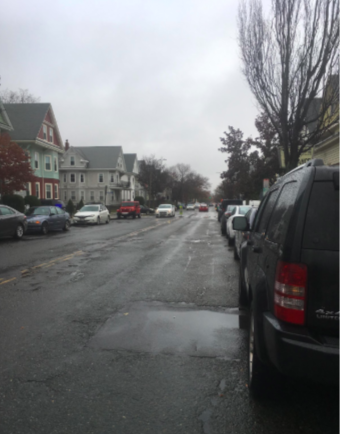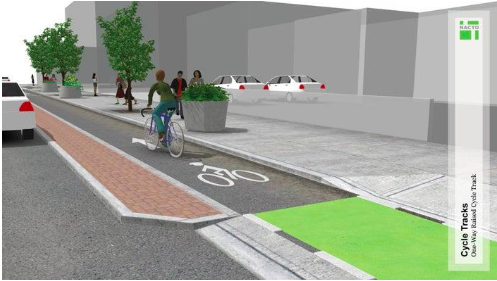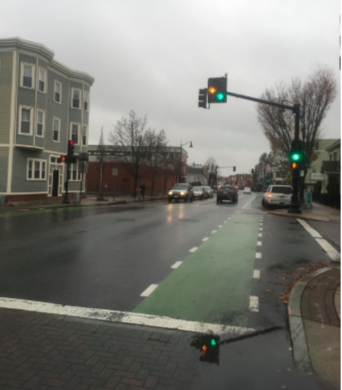Like many cyclists out there, I am a big fan of biking. Around Boston, I can basically bike anywhere I want, wherever I want. I don’t have to stand around waiting for the bus, and it is a great way to start the day, especially before sitting all day at a desk job. It’s quick, efficient, and affordable. And of course, it’s great for the environment.
More than a quarter of Boston’s greenhouse gas emissions come from transportation. Creating safe, accessible biking infrastructure will encourage more people to bike and is one way to help reach our emission reduction goals. The City of Boston has committed to increase bicycling fourfold by 2030. Though just 2.1% of people report bicycling as their primary means of transportation in Boston, more people are biking. While the number of Bostonians commuting by any mode increased by 20% between 2007-2016, the number of people who “usually” bike to work increased 180% in the same time frame. In 2017, according to city data, there was an average of 40,000 bike trips a day in Boston, with 20 percent of those being work commutes. Despite all the talk about electric self-driving cars being the future, this centuries-old method of transportation isn’t going anywhere anytime soon—which means our infrastructure needs to adapt.
While the city has made some progress in making our infrastructure more bike-friendly, in many areas our roads could better support cyclists. Based on my experience biking to work every day, here are three changes that would go a long way towards make biking safer and more appealing:
-
Fewer potholes. It is no fun to bike on a bumpy road, and it can compromise safety, as I’m constantly looking down to anticipate the next bump in the road instead of at my surroundings. Swerving to avoid potholes can also be risky if there is a car behind me that is not alert to my sudden movements.
-
 Protected bike lanes. Narrow streets and congestion make sharing the road with other modes of transport challenging. About a month ago, a driver parked on the side of the street suddenly opened the car door, catching me by surprise. I didn’t react in time, and thankfully just suffered a couple bruises. It turns out, this isn’t as uncommon as I had thought — about 15 to 20 percent of crashes are caused by “dooring.” Accidents like these can be prevented if we separate the parking lane from the bike lane, either by adding a physical barrier or building the bike lane as part of the sidewalk (such as on Beacon Street).
Protected bike lanes. Narrow streets and congestion make sharing the road with other modes of transport challenging. About a month ago, a driver parked on the side of the street suddenly opened the car door, catching me by surprise. I didn’t react in time, and thankfully just suffered a couple bruises. It turns out, this isn’t as uncommon as I had thought — about 15 to 20 percent of crashes are caused by “dooring.” Accidents like these can be prevented if we separate the parking lane from the bike lane, either by adding a physical barrier or building the bike lane as part of the sidewalk (such as on Beacon Street).
- More electric vehicles. Breathing in car exhaust as cars, trucks, and buses inch by you is not pleasant or healthy. Electrifying our public transit buses and encouraging people to switch to electric vehicles will not only make biking a more pleasant experience but will also benefit our public health.
While bike friendly infrastructure goes a long way in encouraging people to bike, these transformations take time and are not necessarily easy or feasible. We will have to be creative with the space and resources we have, and prioritize the most heavily used routes for local bike facility improvements. The Metropolitan Area Planning Council published a study this month based on data from Lime, a bike-sharing company, reporting that about 18 percent of miles traveled by Lime bikers were on stretches classified as “very high stress” – roadways where multiple lanes, high traffic volumes, and no protected bicycle facility make them especially risky for bike-car crashes.
 In the meantime, what can cyclists and drivers do to avoid bike accidents? Cyclists need to constantly be aware of their surroundings (and a little fearless). If you are a cyclist, it might be a good idea to avoid wearing headphones, which are a potential distraction that could compromise your alertness to others sharing the road with you, and thus your safety. Act like a pedestrian and a driver at the same time – wait at the traffic light and don’t assume that drivers see you. If you are a driver, be mindful of cyclists sharing the road and give them space, and if you are parking on the street, look before you open the door — it only takes one person to cause an accident! I think a reason for this is that cyclists are not a regular enough occurrence on the road for drivers to instinctively look around before opening the door. The more cyclists on the road, and the more infrastructure built around creating space for cyclists, the more drivers will start to pay attention to them.
In the meantime, what can cyclists and drivers do to avoid bike accidents? Cyclists need to constantly be aware of their surroundings (and a little fearless). If you are a cyclist, it might be a good idea to avoid wearing headphones, which are a potential distraction that could compromise your alertness to others sharing the road with you, and thus your safety. Act like a pedestrian and a driver at the same time – wait at the traffic light and don’t assume that drivers see you. If you are a driver, be mindful of cyclists sharing the road and give them space, and if you are parking on the street, look before you open the door — it only takes one person to cause an accident! I think a reason for this is that cyclists are not a regular enough occurrence on the road for drivers to instinctively look around before opening the door. The more cyclists on the road, and the more infrastructure built around creating space for cyclists, the more drivers will start to pay attention to them.
Biking is a fast and fun way to get around the city without contributing to carbon emissions. I highly recommend bike share if you don’t want to make the investment or deal with the hassle of owning a bike. I use Bluebikes; they have $20 monthly memberships and $99 annual memberships, and your company might even offer a discount. I’ll certainly be biking for as long as the elements allow.
__________
Justine Huang is a recent graduate of Wellesley College and a Somerville resident. She is an environmental advocate passionate about improving the sustainability of our transportation systems through renewable energy and environmental law and policy.